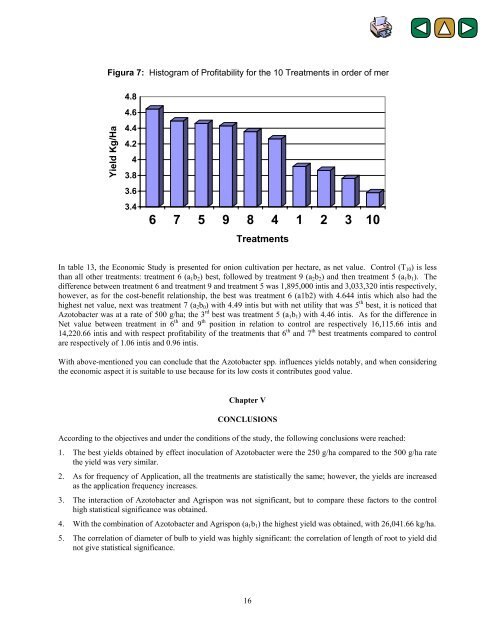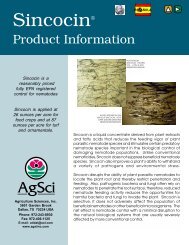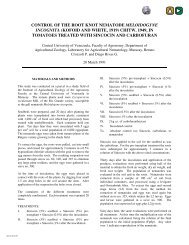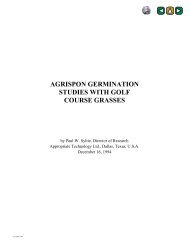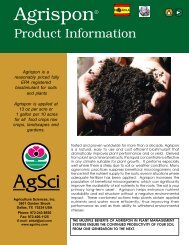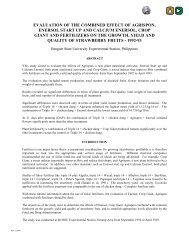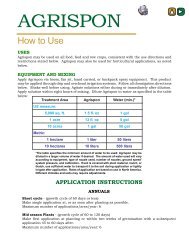R325 - Effect of Different Rate of Azotobacter ... - Agrisciences.com
R325 - Effect of Different Rate of Azotobacter ... - Agrisciences.com
R325 - Effect of Different Rate of Azotobacter ... - Agrisciences.com
Create successful ePaper yourself
Turn your PDF publications into a flip-book with our unique Google optimized e-Paper software.
Figura 7: Histogram <strong>of</strong> Pr<strong>of</strong>itability for the 10 Treatments in order <strong>of</strong> mer<br />
4.8<br />
4.6<br />
Yield Kg/Ha<br />
4.4<br />
4.2<br />
4<br />
3.8<br />
3.6<br />
3.4<br />
6 7 5 9 8 4 1 2 3 10<br />
Treatments<br />
In table 13, the Economic Study is presented for onion cultivation per hectare, as net value. Control (T 10 ) is less<br />
than all other treatments: treatment 6 (a 1 b 2 ) best, followed by treatment 9 (a 2 b 2 ) and then treatment 5 (a 1 b 1 ). The<br />
difference between treatment 6 and treatment 9 and treatment 5 was 1,895,000 intis and 3,033,320 intis respectively,<br />
however, as for the cost-benefit relationship, the best was treatment 6 (a1b2) with 4.644 intis which also had the<br />
highest net value, next was treatment 7 (a 2 b 0 ) with 4.49 intis but with net utility that was 5 th best, it is noticed that<br />
<strong>Azotobacter</strong> was at a rate <strong>of</strong> 500 g/ha; the 3 rd best was treatment 5 (a 1 b 1 ) with 4.46 intis. As for the difference in<br />
Net value between treatment in 6 th and 9 th position in relation to control are respectively 16,115.66 intis and<br />
14,220.66 intis and with respect pr<strong>of</strong>itability <strong>of</strong> the treatments that 6 th and 7 th best treatments <strong>com</strong>pared to control<br />
are respectively <strong>of</strong> 1.06 intis and 0.96 intis.<br />
With above-mentioned you can conclude that the <strong>Azotobacter</strong> spp. influences yields notably, and when considering<br />
the economic aspect it is suitable to use because for its low costs it contributes good value.<br />
Chapter V<br />
CONCLUSIONS<br />
According to the objectives and under the conditions <strong>of</strong> the study, the following conclusions were reached:<br />
1. The best yields obtained by effect inoculation <strong>of</strong> <strong>Azotobacter</strong> were the 250 g/ha <strong>com</strong>pared to the 500 g/ha rate<br />
the yield was very similar.<br />
2. As for frequency <strong>of</strong> Application, all the treatments are statistically the same; however, the yields are increased<br />
as the application frequency increases.<br />
3. The interaction <strong>of</strong> <strong>Azotobacter</strong> and Agrispon was not significant, but to <strong>com</strong>pare these factors to the control<br />
high statistical significance was obtained.<br />
4. With the <strong>com</strong>bination <strong>of</strong> <strong>Azotobacter</strong> and Agrispon (a 1 b 1 ) the highest yield was obtained, with 26,041.66 kg/ha.<br />
5. The correlation <strong>of</strong> diameter <strong>of</strong> bulb to yield was highly significant: the correlation <strong>of</strong> length <strong>of</strong> root to yield did<br />
not give statistical significance.<br />
16


